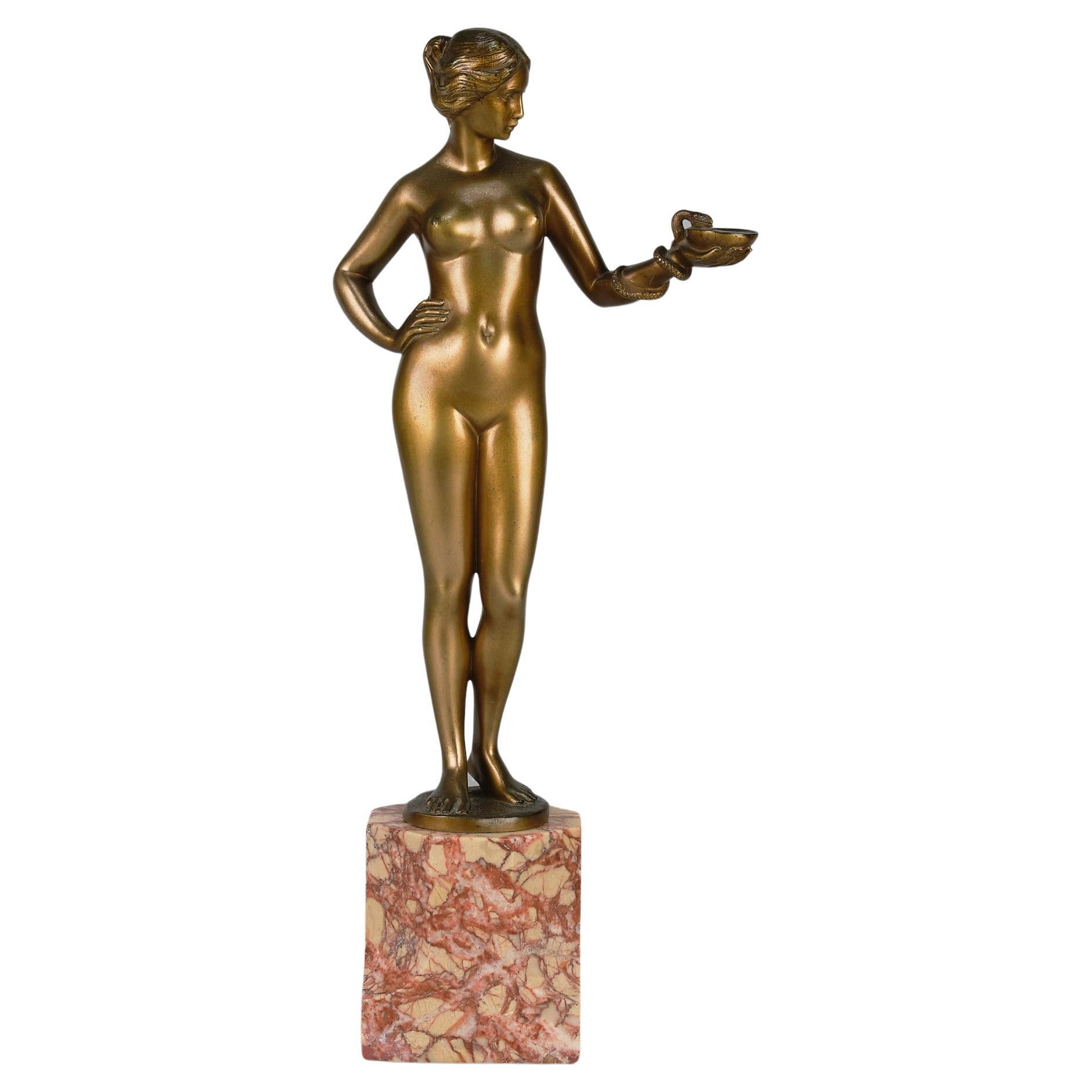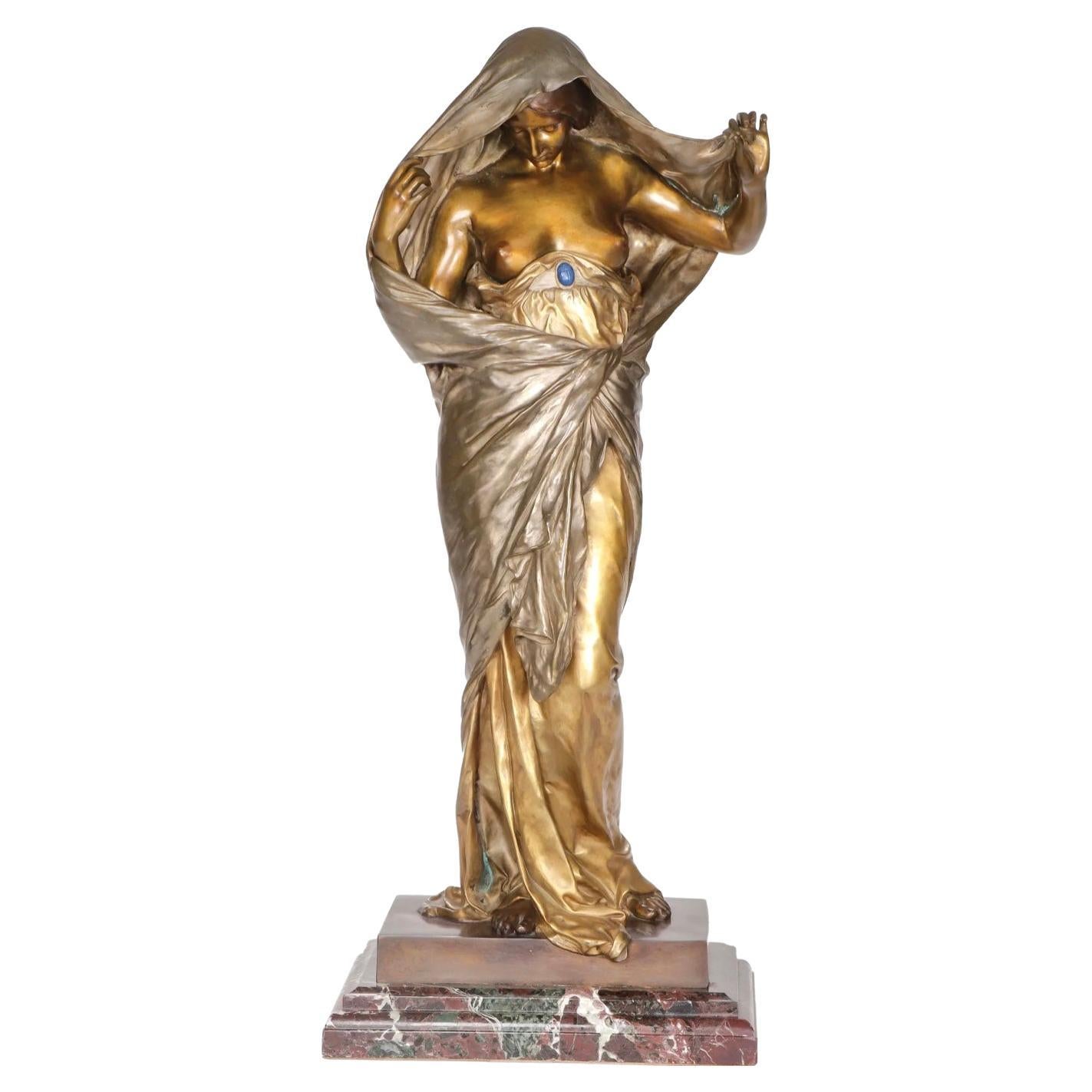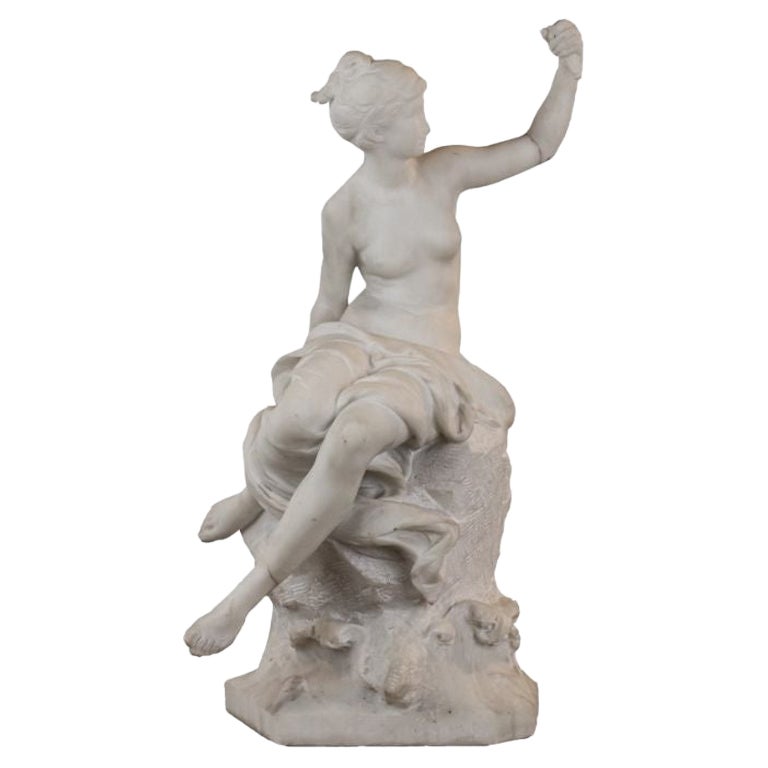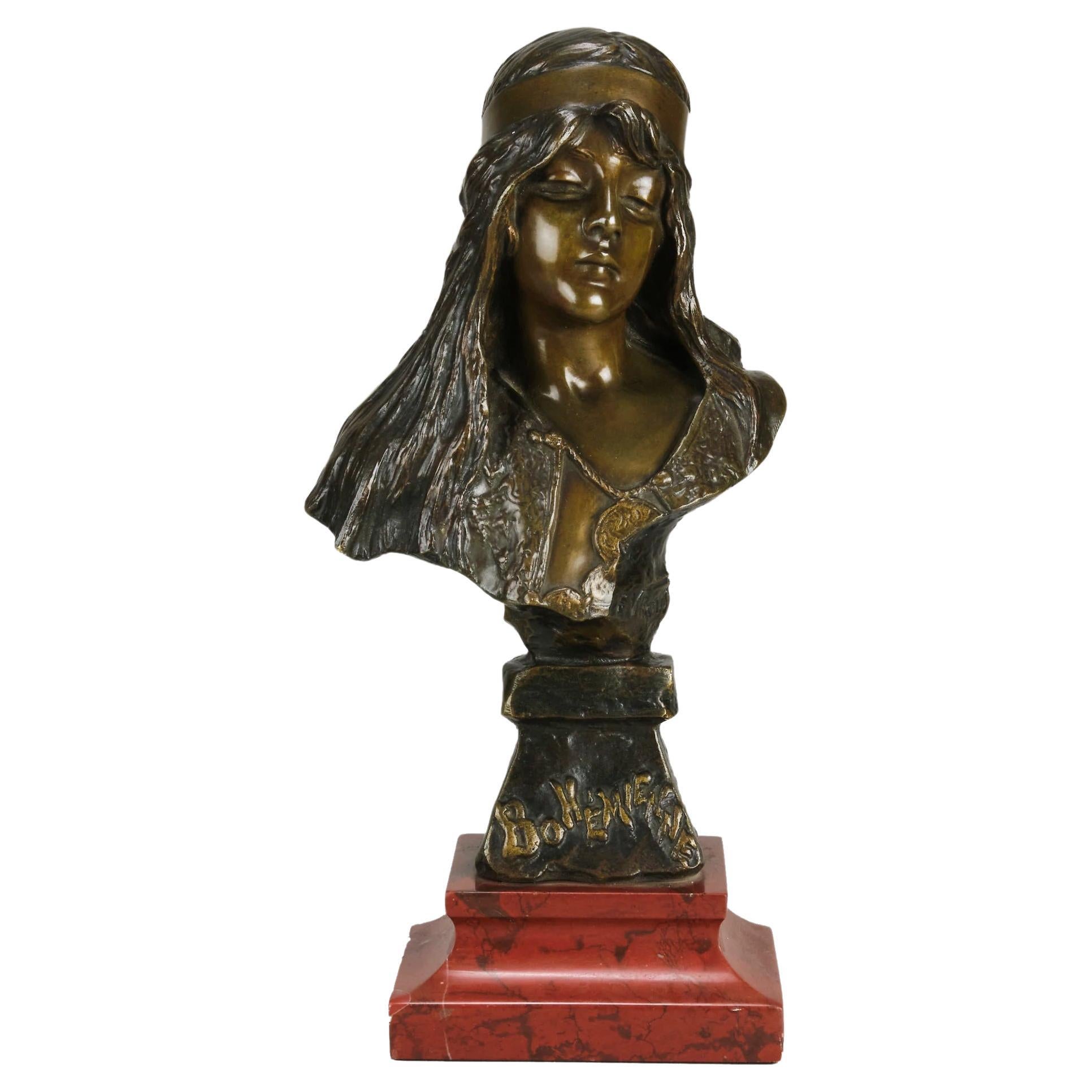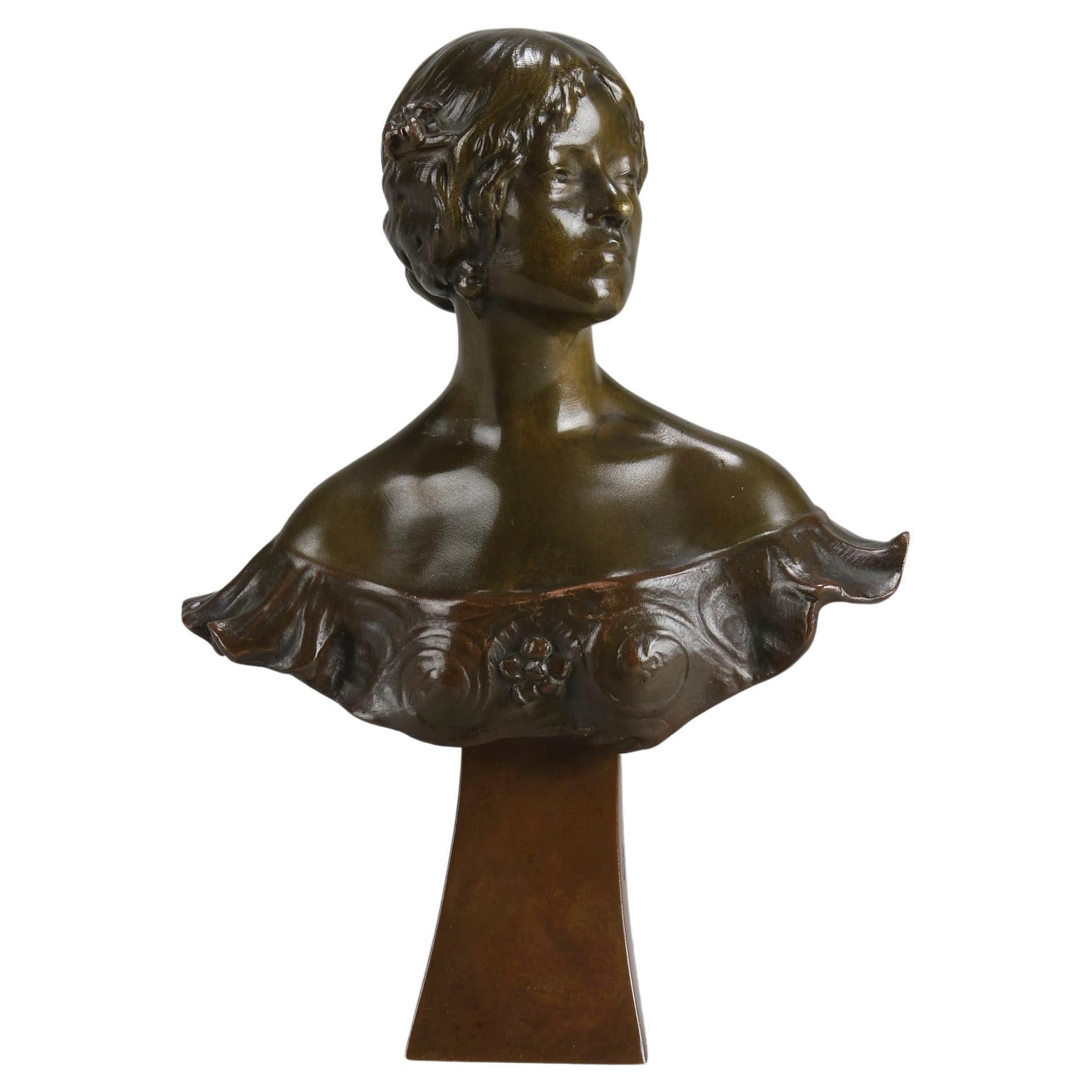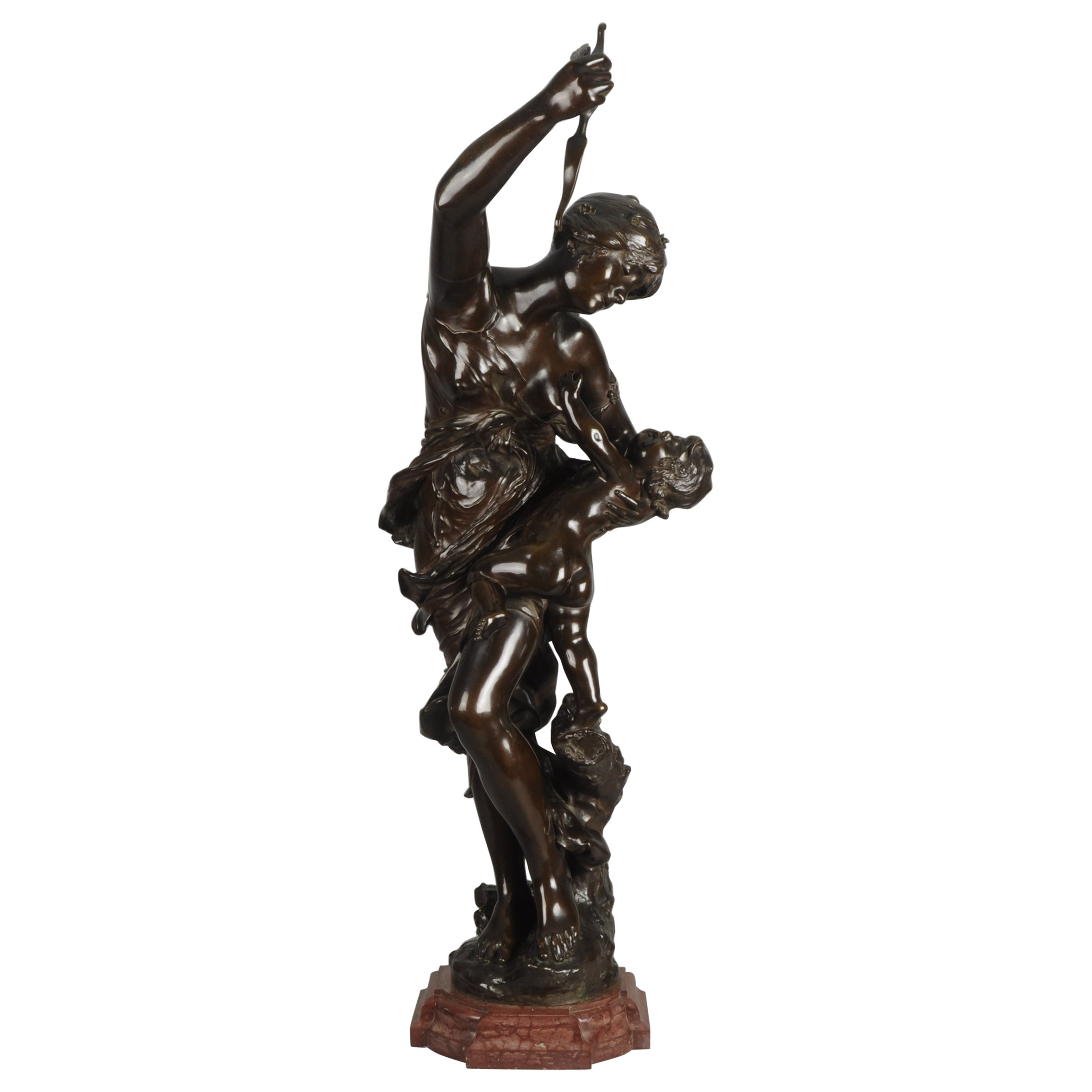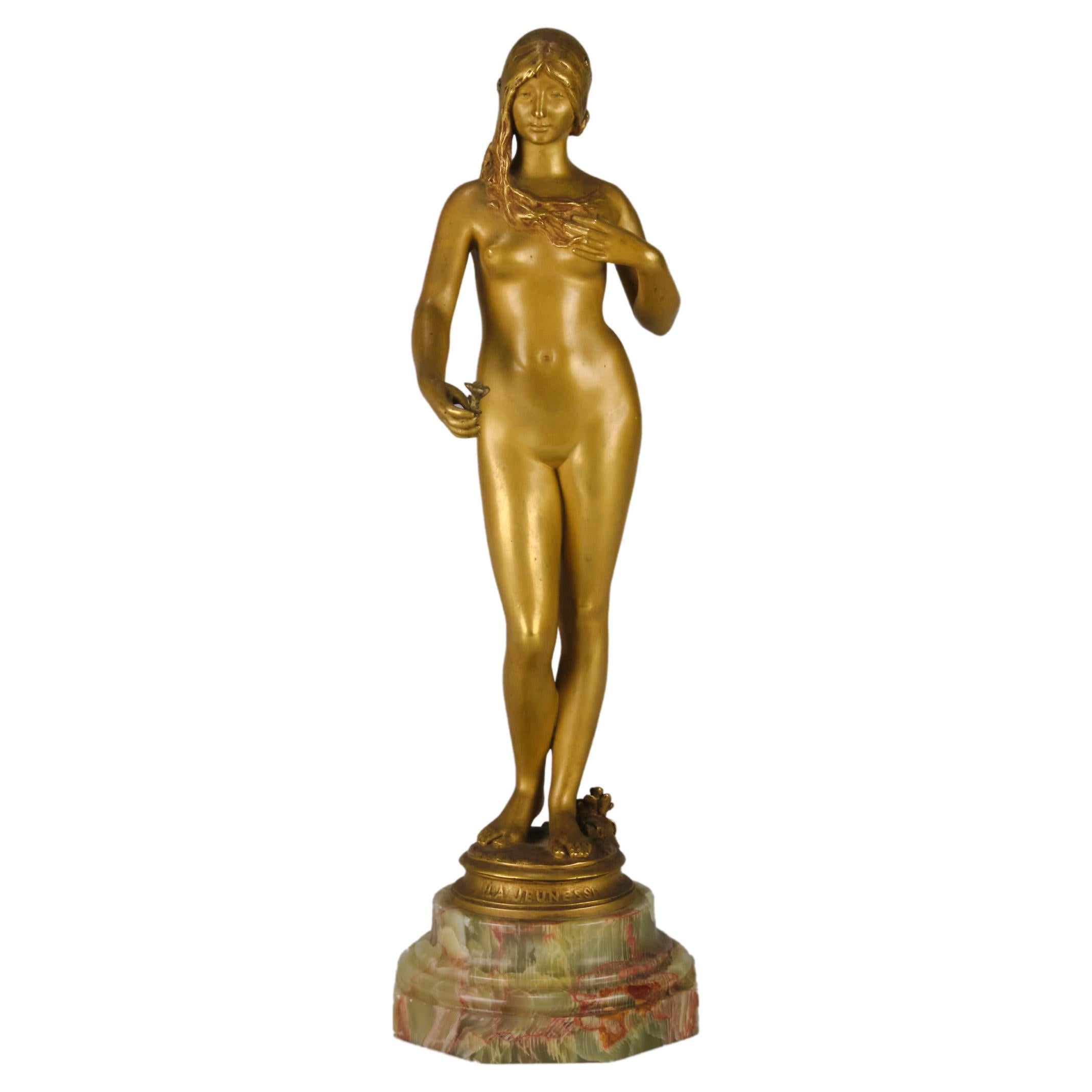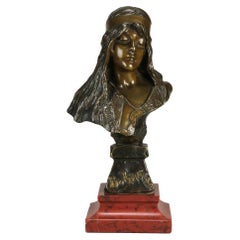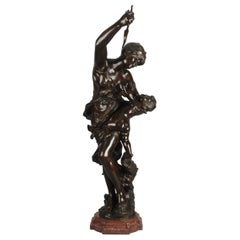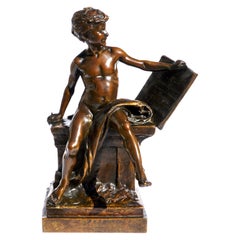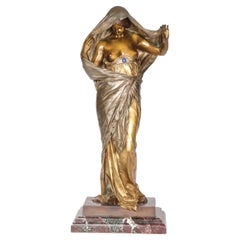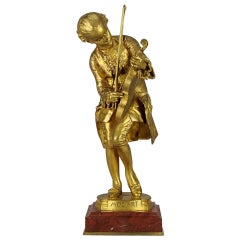
Art Nouveau Gilt Bronze Entitled 'Mozart' by Barrias
View Similar Items
Want more images or videos?
Request additional images or videos from the seller
1 of 12
Art Nouveau Gilt Bronze Entitled 'Mozart' by Barrias
About the Item
- Creator:Louis Ernest Barrias (Sculptor)
- Dimensions:Height: 11.03 in (28 cm)Width: 0 in (0.01 mm)Depth: 0 in (0.01 mm)
- Style:Art Nouveau (Of the Period)
- Materials and Techniques:Bronze,Cast
- Place of Origin:
- Period:1900-1909
- Date of Manufacture:1900
- Condition:Wear consistent with age and use. Excellent Original Condition Please note that our items are genuine antiques with considerable age. It is therefore normal that they will show some signs of wear and handling to the surface.
- Seller Location:London, GB
- Reference Number:Seller: SKU 75491stDibs: LU3216312464013
About the Seller
5.0
Gold Seller
These expertly vetted sellers are highly rated and consistently exceed customer expectations.
Established in 1936
1stDibs seller since 2017
63 sales on 1stDibs
More From This SellerView All
- Art Nouveau Bronze Sculpture Entitled "Cleopatra and Asp" by SchnauderBy Richard Georg SchnauderLocated in London, GBA very fine early 20th Century gilt bronze figure of the famous Cleopatra with a snake wrapped around her wrist drinking from a bowl. Exhibiting fine colour and excellent hand fi...Category
Early 20th Century German Art Nouveau Figurative Sculptures
MaterialsMarble, Bronze
- 19th Century Art Nouveau Bronze Bust Entitled "Bohémienne" by Emmanuel VillanisBy Emmanuel VillanisLocated in London, GBCaptivating late 19th century French bronze bust of a beautiful woman, enhanced by the variegated rich brown patination and excellent tactile surface detail, raised on an integral bronze base with raised title to the fore. Signed ?E Villanis and further raised on a breche griotte stepped and shaped marble plinth ADDITIONAL INFORMATION Height: 33 cm Width: 16 cm Depth: 11 cm Condition: Excellent Original Condition circa: 1890 Materials: Bronze Book Ref: Emmanuel Villanis by Josje Hortulanus-de Mik Page No: 17 SKU: 8616 ABOUT Puccini's Opera - La Bohème SYNOPSIS - A group of friends are living a Bohemian life in Paris and trying to make their livings creating art. Rodolfo, the writer, falls in love with the seamstress, Mimi, while Marcello, the painter, and Musetta, the singer, are the on-and-off-again couple by their sides. When the four are happy, they spend their time celebrating life and love. However, Mimi is revealed to be very ill, and Rodolfo struggles to come to terms with the fact that she will inevitably die. Rodolfo and Mimi break up, and months later, Musetta discovers Mimi extremely sick and close to death. She brings Mimi to Rodolfo and Marcello's apartment. Rodolfo immediately takes her in and tries to nurse her back to health, but he is too late. Almost as soon as the two are reunited and have professed their love for one another, Mimi succumbs to her illness and dies. Emmanuel Villanis Emmanuel Villanis was an industrious man. He is believed to have created some 200 to 250 pieces. His oeuvre pre-eminently consisted of busts and full body statues. Most of these were manufactured in bronze, but there are also models in white metal and terra cotta. Different patinas were used. The bronzes were mainly cast by the Societé de Bronzes de Paris and can be recognised by the round stamp...Category
Antique Late 19th Century French Art Nouveau Busts
MaterialsMarble, Bronze
- 19th Century Art Nouveau Bronze Entitled "Venus & Cupid" by Jean Sul-AbadieBy Jean AbadieLocated in London, GBA very fine bronze study of Venus taking an arrow from Cupid her son, who at times would shoot his arrows without meaning or reason into the hearts of men, igniting their desire. Exhibiting excellent rich brown patina and good detail, signed Sul Abadie and stamped. Additional information Height: 93 cm Condition: excellent condition Circa: 1885 Materials: bronze & marble SKU: 4979 ABOUT Jean Sul-Abadie Jean Sul-Abadie (Born 1850 ~ Died 15th April 1890) was a French artist, a pupil of Jouffroy and Falguière. Specialising in bronze sculpting in the Art Nouveau style. He made his Salon debut in 1872. Cupid & Venus Different tales exist about the origin of Venus and Cupid. Some say that Venus, the goddess of love and beauty, had a love affair with Mars, the god of war. Out of this relationship, Cupid was born. In the following painting you see Venus with Mars, who is being disarmed by Cupid. Cupid has attributes from both of his parents. Like his mother he is considered to be the god of love, or more precisely, the god of falling in love. He is portrayed as an innocent little child with bow and arrows. He shoots arrows to the heart, and awakening a love that you’re powerless to resist. In classical mythology, Cupid (Latin Cupido, meaning “desire”) is the god of desire, erotic love, attraction and affection. He is often portrayed as the son of the love goddess Venus and the war god Mars, and is known in Latin also as Amor (“Love”). His Greek counterpart is Eros. Although Eros is in Classical Greek art as a slender winged youth, during the Hellenistic period, he was increasingly portrayed as a chubby boy. During this time, his iconography acquired the bow and arrow that represent his source of power: a person, or even a deity, who is shot by Cupid’s arrow is filled with uncontrollable desire. In myths, Cupid is a minor character who serves mostly to set the plot in motion. He is a main character only in the tale of Cupid and Psyche, when wounded by his own weapons he experiences the ordeal of love. Although other extended stories are not told about him, his tradition is rich in poetic themes and visual scenarios, such as “Love conquers all” and the retaliatory punishment or torture of Cupid. In art, Cupid often appears in multiples as the Amores, or amoriniin the later terminology of art history, the equivalent of the Greek erotes. Cupids are a frequent motif of both Roman art and later Western art of the classical tradition. In the 15th century, the iconography of Cupid starts to become indistinguishable from the putto. Cupid continued to be a popular figure in the Middle Ages, when under Christian influence he often had a dual nature as Heavenly and Earthly love. In the Renaissance, a renewed interest in classical philosophy endowed him with complex allegorical meanings. In contemporary popular culture, Cupid is shown drawing his bow to inspire romantic love, often as an icon of Valentine’s Day. Venus is the Roman goddess whose functions encompassed love, beauty, sex, fertility, prosperity, victory, and desire. In Roman mythology, she was the mother of the Roman people through her son, Aeneas, who survived the fall of Troy...Category
Antique Late 19th Century French Art Nouveau Figurative Sculptures
MaterialsBreccia Marble, Bronze
- Early 20th Centrury French Bronze Entitled Art Nouveau Bust by Alexandre CaronBy A. CaronLocated in London, GBAn excellent French early 20th Century Art Nouveau bronze bust of a beautiful young woman waering an off the shoulder blouse. Raised on a slend...Category
Antique Early 1900s French Art Nouveau Busts
MaterialsBronze
- Late 19th Century Art Nouveau Bronze Entitled "Broken Jug" by Charles AnfrieBy Charles AnfrieLocated in London, GBA very fine late 19th century bronze figure of a young lad dressed in period attire holding a broken jug, with excellent rich brown patina and fabulous hand finished surface detail, signed & titled ADDITIONAL INFORMATION Height: 20 cm Condition: excellent original condition Circa: 1890 Materials: Bronze SKU: 8279 ABOUT Charles Anfrie...Category
Antique 1890s French Art Nouveau Figurative Sculptures
MaterialsBronze
- Early 20th Century Art Nouveau Bronze Entitled "La Jeuneuse" by Antonin CarlèsBy Antonin CarlèsLocated in London, GBA delightful Art Nouveau early 20th Century gilt bronze figure of a very beautiful young lady holding a flower in her right hand, the surface of the bronze exhibiting fine detail and...Category
Antique Early 1900s French Art Nouveau Figurative Sculptures
MaterialsBronze
You May Also Like
- Unique Cire Perdue Gilt Bronze Sculpture of Roses by Louis Ernest BarriasBy Louis Ernest BarriasLocated in Philadelphia, PAA unique Cire Perdue gilt bronze sculpture of roses by Louis Ernest Barrias. The singular lost wax cast of a still life of roses is mounted on a rosewoo...Category
Antique Late 19th Century French Beaux Arts Figurative Sculptures
MaterialsBronze
- Louis Ernest Barrias Bronze SculptureBy Louis Ernest BarriasLocated in Dallas, TXFrench dore bronze depicting a seated figure of a boy with tablet by Louis Ernest Barrias, French(1841-1905) Circa 1912 Modeled as a partially nude youth seated with a tablet and pen, incised E. Barrias and Susse Frères and Susse Frères pastille mark Signed “E. Barrias” w/ Susse Freres Foundry Mark and reduction stamp.. Condition: Mint with superb chocolate brown patina. Measure: 12.25" high x 8.25" wide x 7.2” depth AVANTIQUES is dedicated to providing an exclusive curated collection of Fine Arts, Paintings, Bronzes, Asian treasures, Art Glass and Antiques. Our inventory represents time-tested investment quality items with everlasting decorative beauty. We look forward to your business and appreciate any reasonable offers. Louis-Ernest Barrias (13 April 1841 – 4 February 1905) was a French sculptor of the Beaux-Arts school. In 1865 Barrias won the Prix de Rome for study at the French Academy in Rome. Barrias was involved in the decoration of the Paris Opéra and the Hôtel de la Païva in the Champs-Élysées. His work was mostly in marble, in a Romantic realist style indebted to Jean-Baptiste Carpeaux. He was born in Paris into a family of artists. His father was a porcelain-painter, and his older brother Félix-Joseph Barrias a well-known painter. Louis-Ernest also started out as a painter, studying under Léon Cogniet, but later took up sculpture with Pierre-Jules Cavelier as teacher. In 1858 he was admitted to the École nationale supérieure des Beaux-Arts in Paris, where his teacher was François Jouffroy. In 1865 Barrias won the Prix de Rome for study at the French Academy in Rome. Barrias was involved in the decoration of the Paris Opéra and the Hôtel de la Païva in the Champs-Élysées. His work was mostly in marble, in a Romantic realist style indebted to Jean-Baptiste Carpeaux. In 1878 he was made a knight of the Legion of Honour, an officer in 1881, and a commander in 1900. Barrias replaced Dumont at the Institut de France in 1884 then succeeded Cavelier as professor at the École des Beaux-Arts. In 1900-03 he served on the Council for the National Museums. Among his students were Josep Clarà, Charles Despiau, Henri Bouchard...Category
Vintage 1910s French Beaux Arts Figurative Sculptures
MaterialsBronze
- Louis Ernest Barrias Nature Revealing HerselfBy Louis Ernest BarriasLocated in Dallas, TXLouis Ernest Barrias (French 1841-1905) Nature Revealing Herself La Nature se dévoilant devant la Science Gilt, and silver patinated bronze with blue glass scarab Signed on base “E. Barrias” and with Susse Fres foundry mark. Height: 22.5 inches (57 cm) With original rouge marble base 24 inches (61 cm) Condition: Excellent with no damage or repairs. wear commensurate of age and use. Minor tarnishing, scuffs with chips to marble base. Nature Unveiling Herself Before Science (La Nature se dévoilant à la Science) is an allegorical sculpture created in 1899 in the Art Nouveau style by Louis-Ernest Barrias. The sculpture depicts a woman—personifying Nature—removing a veil to reveal her face and bare breasts. The sculpture, which is in the Musée d'Orsay, was commissioned for the Conservatoire National des Arts et Métiers. Underneath the veil, Nature wears a gown held up by a scarab. The figure is made of marble, with the gown made of Algerian onyx, and the scarab of malachite. The sculpture has also been reproduced in other media. According to historians of science Lorraine Daston and Peter Galison, the sculpture "blends the ancient trope of the veil of Isis, interpreted as nature's desire to hide her secrets, with the modern fantasy of (female) nature willingly revealing herself to the (male) scientist, without violence or artifice." According to historian of science Carolyn Merchant, the sculpture is emblematic of transformation of conceptions of nature that came with the Scientific Revolution: "From an active teacher and parent, she [Nature] has become a mindless, submissive body." In a similar vein, biologist and essayist Gerald Weissmann has noted the similarity between Nature's pose in Barrias' sculpture and that of the central figure in the 1876 painting Dr. Pinel Unchaining the Mad by Tony Robert-Fleury, a released inmate from an insane asylum...Category
Antique Early 1900s French Art Nouveau Figurative Sculptures
MaterialsBronze
- Bronze Figure of Jeanne d'Arc From The Model By Louis Ernest BarriasBy Louis Ernest BarriasLocated in Brighton, West SussexA Large Patinated Bronze Figure of ‘Jeanne d'Arc Prisonnière’ (‘Prisoner Joan of Arc’), By Louis-Ernest Barrias (French, 1841–1905). Joan of Arc modelled standing, in handcuffs and armour and wearing a Bascinet helmet. Signed ‘E. Barrias’ and with foundry mark ‘Susse Fres Edit Paris', Stamped 'PS'. Titled on the base: ‘Vous avez pu m'enchainer/vous n'enchainerez jamais la Fortune de la France/Jeanne d'Arc’ ('You were able to chain me but you will never chain the will of France. Joan of Arc’). Cast as part of a limited edition by the Susse Frères foundry, Paris, from the model by Louis-Ernest Barrias (French, 1841 – 1905). The model conceived Circa 1891 and Cast Circa 1910. In 1891 Barrias completed his touching life-size portrait of 'Jeanne d'Arc devant ses judges' ('Joan of Arc before the judges') in marble for her monument at the Church...Category
Antique 19th Century French Figurative Sculptures
MaterialsBronze
- 19th Century Venus Sculpture Marble by BarriasBy Louis Ernest BarriasLocated in Milan, ITLouis-Ernest Barrias (Paris, 1841 - there, 1905) Venus Marble, h. 59 cm, 5 Signed "E Barrias" The renewal of classical beauty was exploited during the course of the nineteen...Category
Antique 19th Century Italian Figurative Sculptures
MaterialsMarble
- Art Nouveau Gilt Bronze Hand MirrorLocated in Fairfax, VAMasterfully crafted in France during the early 20th century, this hand mirror is truly timeless. Made of beautiful bronze doré; this mirror features beveled glass and an elegant orga...Category
Early 20th Century French Art Nouveau Sculptures
MaterialsBronze
Recently Viewed
View AllMore Ways To Browse
Bronze Violin
Mozart Sculpture
Barrias Bronze
Mozart Bronze
Antique Italian Living Room Set
Antique Baroque Decorative
Art Deco Other Antique Furniture
Carved Palm
Art Deco Metal Sculpture
Wood Carved Man
Grand Tour Bronze
Bronze Grand Tour
Antique Art Deco Other Antique Furniture
1920s Deco Sculptures
Vintage Wood Plaster
Antique Bronze Plaque
Antique Bronze Plaques
16th Century Wood Furniture


